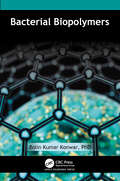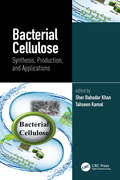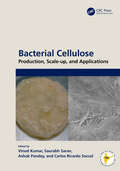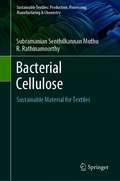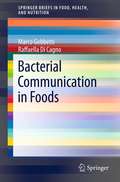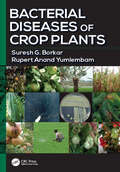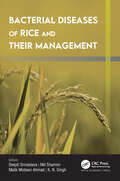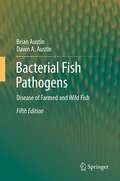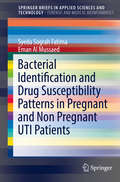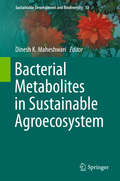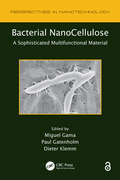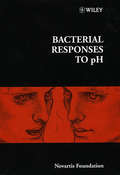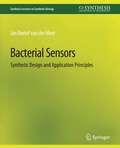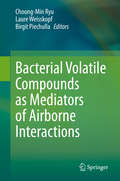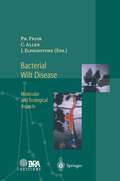- Table View
- List View
Bacterial Biopolymers
by Bolin Kumar KonwarBacterial biopolymers are a competitive new area of research with potential applications in agriculture, petroleum exploration, and use as biodegradable plastics. This new volume provides comprehensive coverage of bacterial biopolymers. The book elucidates the main classes of bacterial biopolymers—polysaccharides and polyesters or polyhydroxyalkanoates (PHAs)—along with their definition, classification, detection, extraction, characterization, fermentation process, structure and properties, applications and uses, functions, and more. The volume covers Detection, extraction, and characterization of bacterial biopolymers Molecular identification of bacterial isolates The fermentation process Structure and properties of PHAs Biochemical characterization of the PHA-producing bacterial strains In vitro biodegradation study of PHA film by soil microorganisms PHAs for enhancing the stability of colloidal silver nanoparticles (SNP) This volume is an important source of information on the concerned bacteria, the biochemical characteristics of biopolymers, and their potential use.
Bacterial Cellulose: Synthesis, Production, and Applications
by Sher Bahadar Khan Tahseen KamalBacterial cellulose (BC) is a natural polymer produced by different microbial cells. Its unique structural, physico-chemical, mechanical, thermal, and biological properties offer much potential for use in diverse applications in the biomedical, electronics, energy, and environmental fields, among others. This text provides an overview of the synthesis, characterization, modification, and application of BC. • Discusses sources, characterization, and biosynthesis of BC • Covers composites and aerogels based on BCs • Describes development of BCs from waste and challenges in large-scale production of BCs • Explores a variety of applications such as environmental, industrial, and biomedical This book will be of great interest to researchers and industry professionals in materials science, chemical engineering, chemistry, and other related fields seeking to learn about the synthesis and application of this important material.
Bacterial Cellulose: Synthesis, Production, and Applications
by Sher Bahadar Khan Tahseen KamalBacterial cellulose (BC) is a natural polymer produced by different microbial cells. Its unique structural, physico-chemical, mechanical, thermal, and biological properties offer much potential for use in diverse applications in the biomedical, electronics, energy, and environmental fields, among others. This text provides an overview of the synthesis, characterization, modification, and application of BC. • Discusses sources, characterization, and biosynthesis of BC • Covers composites and aerogels based on BCs • Describes development of BCs from waste and challenges in large-scale production of BCs • Explores a variety of applications such as environmental, industrial, and biomedical This book will be of great interest to researchers and industry professionals in materials science, chemical engineering, chemistry, and other related fields seeking to learn about the synthesis and application of this important material.
Bacterial Cellulose: Production, Scale-up, and Applications
by Vinod Kumar Saurabh Saran Ashok Pandey Carlos Ricardo SoccolThis reference book provides updated information on the production and industrial significance of bacterial cellulose. Bacterial cellulose is a natural fiber produced by certain microbes, mainly bacteria which belong to the Acetobacter genera. The book discusses its applications in different industrial sectors, such as food, pharmaceutical, energy, and wastewater treatment. It covers the production of cellulose from conventional and renewable feedstock and includes topics such as downstream processing, characterization, and chemical modification of bacterial cellulose. FEATURES Addresses the challenges of the production technologies of bacterial cellulose up to pilot scale Discusses cost-effective green processes using agri-processing residues and medium formulation Includes efficient preparation of nanocomposites using in vitro and in vivo methods Provides the latest applications of bacterial cellulose in the food and pharmaceuticals fields Reviews the production of bacterial cellulose from conventional feedstock such as sugars and starches This book is designed for industry experts and researchers of applied microbiology, bioprocesses, and industrial microbiology.
Bacterial Cellulose: Production, Scale-up, and Applications
by Vinod Kumar Saurabh Saran Ashok Pandey Carlos Ricardo SoccolThis reference book provides updated information on the production and industrial significance of bacterial cellulose. Bacterial cellulose is a natural fiber produced by certain microbes, mainly bacteria which belong to the Acetobacter genera. The book discusses its applications in different industrial sectors, such as food, pharmaceutical, energy, and wastewater treatment. It covers the production of cellulose from conventional and renewable feedstock and includes topics such as downstream processing, characterization, and chemical modification of bacterial cellulose. FEATURES Addresses the challenges of the production technologies of bacterial cellulose up to pilot scale Discusses cost-effective green processes using agri-processing residues and medium formulation Includes efficient preparation of nanocomposites using in vitro and in vivo methods Provides the latest applications of bacterial cellulose in the food and pharmaceuticals fields Reviews the production of bacterial cellulose from conventional feedstock such as sugars and starches This book is designed for industry experts and researchers of applied microbiology, bioprocesses, and industrial microbiology.
Bacterial Cellulose: Sustainable Material for Textiles (Sustainable Textiles: Production, Processing, Manufacturing & Chemistry)
by Subramanian Senthilkannan Muthu R. RathinamoorthyThis book presents the potential of bacterial cellulose in the textile and fashion industry. Most of the earlier work on the bacterial cellulose was focused on the bio technology application of cellulose, but the recent urge for the need of a sustainable material in the fashion and textile industries identified the scope of the bacterial cellulose in this aspect. The unique feature of this book is that it relates the bio technological aspects of bacterial cellulose with the sustainable issues in the fashion industry.
Bacterial Communication in Foods (SpringerBriefs in Food, Health, and Nutrition)
by Marco Gobbetti Raffaella Di CagnoIt is generally assumed that microorganisms synthesize, release, detect and respond to small signaling hormone-like molecules. These molecules are used for a process termed “quorum sensing” (QS), a phenomenon that enables bacteria to sense when the minimal number of cells, or “quorum,” is achieved for a concerted response to be initiated. Words such as “language” and “behavior” are frequently used to depict QS in the literature. More simply put, language and cross-talk between bacteria, and between bacteria and animal or plant hosts, determines the behavior (e.g., beneficial or pathogenic effects) of bacteria. Currently, the major concern is to understand and decode this language. Overall, bacterial cross-talk was mainly studied on environmental, plant, and human pathogenic bacteria. Few studies considered food-related lactic acid bacteria. The cross-talk between bacteria influences the behavior and, in turn, the environmental adaptation and phenotypes. Therefore, it is understood that bacterial cross-talk has important applicative repercussions. The language spoken between bacteria populating the same food ecosystem may condition the phenotypic traits of starter lactic acid bacteria and, consequently, their performance. This Brief aims to define the basis of cell-to-cell signalling in food fermentation and will highlight: (i) microbiology, nutritional, chemical and functional aspects; (ii) functional properties due to microbial adaptation to the gastrointestinal tract; (iii) principal phenotypes under control of QS circuitries; (iv) quorum quenching. This Brief will be the first reference on this topic and it will highlight the main results for a more productive industrial application. Draft content 1. Signals of food related Gram-negative and Gram-positive bacteria The chapter will describe the different signaling languages used by Gram-negative bacteria (N-acyl-L-homoserine lactones) and Gram-positive bacteria (based on the synthesis of post-translationally modified peptides) and the universal chemical lexicon, shared by both Gram-positive and -negative bacteria (autoinducer-2 through the activity of the LuxS enzyme). 2. Phenotypes related to quorum sensing The chapter will describe the bacterial phenotypes, such as virulence, biofilm maturation, bacteriocin synthesis, and secondary metabolite production under control of QS circuitries. 3. Cell-to-cell signalling in fermented food: sourdough The chapter will describe the language spoken between bacteria populating the same food ecosystem (sourdough) and will provide an overview of the conditioned phenotypic traits of starter lactic acid bacteria and, consequently, their performance. 4. Cell-to-cell signalling in fermented food: yoghurt The chapter will describe the language spoken between bacteria populating the same food ecosystem (yoghurt) and will provide an overview of the conditioned phenotypic traits of starter lactic acid bacteria and, consequently, their performance. 5. Probiotic message at the intra-, inter-species and inter-kingdom level The chapter will describe the mechanisms that regulate the interaction between microorganism and host, and the capacity of the microorganism to adapt to environment. Particular reference will also be made to: (i) pathogen inhibition and restoration of microbial homeostasis through microbe-microbe interactions; (ii) enhancement of epithelial barrier function; and (iii) modulation of immune responses. 6. New Perspectives of quorum sensing This chapter will provide an overview of the future perspective regarding quorum sensing, showing that bacterial cross-talk may have important applicative repercussions. It will highlight the interference on the language of QS, which is defined as quorum quenching (QQ). Increasing translation of the bacterial cross-talk has shown that in some environmental circumstances, quenching of the language may occur.
Bacterial Diseases of Crop Plants
by Suresh G. Borkar Rupert Anand YumlembamFood and agriculture is an important component in the development and survival of civilizations. Around half of the world’s population and their economies are influenced by agricultural farm production. Plant diseases take as much as a 30 percent toll of the crop harvest if not managed properly and efficiently. Bacterial diseases of crop plants are important in plant disease scenarios worldwide and are observed on all kinds of cultivated and commercial value plants including cereals, pulses, oilseeds, fruits, vegetables, cash crops, plantation crops, spices, ornamentals and flowering plant, forage crop, forest trees, and lawn grasses. Bacterial diseases are widespread and are difficult to identify and to control. Few pesticides are available for use in control, and many plant pathologists are not well trained in the management of bacterial diseases. Bacterial Diseases of Crop Plants offers concise information on bacterial diseases of crops, proving a valuable asset to students, scientists in industry and academia, farmers, extension workers, and those who deal with crops that are vulnerable to bacterial diseases. The book contains 13 chapters featuring bacterial diseases of individual crops and is illustrated with full color photographs throughout providing amazing characterization of the diseases. It also includes information on bacterial diseases that appear on different crops across the continents, thereby making the content of interest to plant pathologists around the world. Bacterial diseases are of great economic concern, and their importance in overall losses caused by various other pathogens, such as fungi and viruses, is often undermined in developing countries.
Bacterial Diseases of Crop Plants
by Suresh G. Borkar Rupert Anand YumlembamFood and agriculture is an important component in the development and survival of civilizations. Around half of the world’s population and their economies are influenced by agricultural farm production. Plant diseases take as much as a 30 percent toll of the crop harvest if not managed properly and efficiently. Bacterial diseases of crop plants are important in plant disease scenarios worldwide and are observed on all kinds of cultivated and commercial value plants including cereals, pulses, oilseeds, fruits, vegetables, cash crops, plantation crops, spices, ornamentals and flowering plant, forage crop, forest trees, and lawn grasses. Bacterial diseases are widespread and are difficult to identify and to control. Few pesticides are available for use in control, and many plant pathologists are not well trained in the management of bacterial diseases. Bacterial Diseases of Crop Plants offers concise information on bacterial diseases of crops, proving a valuable asset to students, scientists in industry and academia, farmers, extension workers, and those who deal with crops that are vulnerable to bacterial diseases. The book contains 13 chapters featuring bacterial diseases of individual crops and is illustrated with full color photographs throughout providing amazing characterization of the diseases. It also includes information on bacterial diseases that appear on different crops across the continents, thereby making the content of interest to plant pathologists around the world. Bacterial diseases are of great economic concern, and their importance in overall losses caused by various other pathogens, such as fungi and viruses, is often undermined in developing countries.
Bacterial Diseases of Rice and Their Management (Innovations in Agricultural & Biological Engineering)
by Deepti Srivastava Md. Shamim Malik Mobeen Ahmad K. N. SinghRice is a major staple food and a source of nutrition for over 3.5 billion people worldwide. It is, however, susceptible to a number of bacterial diseases that decrease its yield and quality. This book covers the bacterial diseases of rice and their management, focusing on sustainable management methods that involve biological control, conventional breeding, and molecular methods. It covers the biology of rice bacterial blight pathogens, virulence determinants, and host defense factors of bacterial blight pathogen-rice interactions. Different resistance rice cultivars, their resistance loci, and quantitative trait loci mapping in the important rice cultivars are also discussed. The book presents biological studies of the major rice bacterial diseases (rice bacterial brown stripe disease, bacterial leaf streak disease, rice bacterial panicle blight disease, rice bacterial foot rot, sheath brown rot disease) and presents comparative analyses of conventional breeding, and molecular management approaches, along with examples.
Bacterial Diseases of Rice and Their Management (Innovations in Agricultural & Biological Engineering)
Rice is a major staple food and a source of nutrition for over 3.5 billion people worldwide. It is, however, susceptible to a number of bacterial diseases that decrease its yield and quality. This book covers the bacterial diseases of rice and their management, focusing on sustainable management methods that involve biological control, conventional breeding, and molecular methods. It covers the biology of rice bacterial blight pathogens, virulence determinants, and host defense factors of bacterial blight pathogen-rice interactions. Different resistance rice cultivars, their resistance loci, and quantitative trait loci mapping in the important rice cultivars are also discussed. The book presents biological studies of the major rice bacterial diseases (rice bacterial brown stripe disease, bacterial leaf streak disease, rice bacterial panicle blight disease, rice bacterial foot rot, sheath brown rot disease) and presents comparative analyses of conventional breeding, and molecular management approaches, along with examples.
Bacterial Fish Pathogens: Disease of Farmed and Wild Fish
by Brian Austin Dawn A. AustinThis completely updated fifth edition of Bacterial Fish Pathogens is a comprehensive discussion of the biological aspects of the bacteria which cause disease in farmed and wild fish. Since the 4th edition was published in 2007, there has been an upturn in the application of molecular approaches to taxonomy, diagnosis and vaccine development. New pathogens, e.g. Aeromonas schubertii, have been described. Also, there has been the emergence of diseases caused by bacteria which have not been cultured, and which have been equated with new taxa, i.e. ‘Candidatus’. Consideration is given to all the bacterial fish pathogens, including primary pathogens and opportunists.
Bacterial Identification and Drug Susceptibility Patterns in Pregnant and Non Pregnant UTI Patients (SpringerBriefs in Applied Sciences and Technology)
by Syeda Sograh Fatima Eman Al MussaedThis book provides a review of essential research on urinary tract infections (UTIs), as well as a broader perspective on methodologies adopted for the isolation and identification of the bacteria from urine samples of pregnant and non-pregnant women on the basis of their cultural, morphological and biochemical characteristics. The identification is extended to the strain level by means of molecular identification involving BLAST as a bioinformatics tool. The book also addresses the roles of various other bioinformatics tools for tracing the phylogenetic tree and conservation studies among the bacteriocin of the identified bacteria. Lastly, it assesses the antibiotics resistance patterns of these isolates.
Bacterial Metabolites in Sustainable Agroecosystem (Sustainable Development and Biodiversity #12)
by Dinesh K. MaheshwariThere has been a resurgence of interest in environmental friendly, sustainable and organic cultural practices that warrants high yield and quality in agricultural crops. To enhance sustainable agricultural production and alleviate food scarcity, spoor of majority of microorganisms, especially plant growth and health promoting bacteria of eminent characteristics that allow them for exploitation in agro-ecosystem. Plant growth promoting rhizobacteria are the soil bacteria inhabiting around/on the root surface and are directly or indirectly involved in promoting plant growth and development via production and secretion of various regulatory chemicals in the vicinity of rhizosphere. Among various beneficial bacteria mediated mechanisms include direct production of phytohormones and biosurfactants experiencing quest of research and concept up gradation that can built emerging paradigm (agriculture model). Research on bacteria-mediated phytohormones is crucially important, provides key understanding of the plant growth and development. Various genera including PGPR group of bacteria are potential source of plant growth regulators. Application of such organism allow plants to survive under abiotic and biotic stress conditions besides govern phytohormone mediated immune response and manage to regulate hormones. Such group of bacteria also produce another important metabolite i.e. biosurfacatants which are involved in many important functions to bacteria itself as well as for the plants and their ecosystem. Biosurfactants may alter nutrient availability, endogenous metabolites such as antibiotics production, root colonization imparting protection from phytopathogens besides eradicating soil contaminants and other pollutants. The role and activities of surfactants produced by bacteria are multifarious in nature. Thus, bacterial phytohormones and biosurfactants are identified as effector molecules in plant- microbe interactions, in pathogenesis and phyto-stimulation which can either be beneficial for the bacteria itself or for the crops. This book highlights current applications and research on bacterial hormones and surfactants to provide a timely overview. The chapters have been contributed by subject experts from around the world and include topics of varied importance which include phytohormones production by rhizospheric and endophytic bacteria, their role in rhizosphere competence, plant growth regulation, bioremediation, biosurfactants as antibiofilm agents and other aspects. This major new work represents a valuable source of information to all those scientists interested in microbial technology with respect to the microbial innovative products and applications towards sustainable agroecosystem.
Bacterial NanoCellulose: A Sophisticated Multifunctional Material (Perspectives In Nanotechnology Ser. #9)
by Miguel GamaThe first book dedicated to the potential applications and unique properties of bacterial cellulose (BC), this seminal work covers the basic science, technology, and economic impact of this bulk chemical as well as the companies and patents that are driving the field. It reviews the biosynthesis and properties of BC, including genetics and characterization; discusses the advancing technology as it relates to product development, bioreactors, and production; and analyzes the economic impact of BC on a diverse range of industry applications, including materials and biomaterials, biological and polymer sciences, and electromechanical engineering.
Bacterial NanoCellulose: A Sophisticated Multifunctional Material
by Miguel Gama Paul Gatenholm Dieter KlemmeBacterial nanocellulose (BNC) is an emerging nanomaterial with unique properties produced by several species of ubiquitous fermentation bacteria, most importantly Gluconacetobacter xylinus, previously known as Acetobacter xylinum. BNC has been used for a variety of commercial applications including textiles, cosmetics, and food products, and it has
Bacterial Responses to pH (Novartis Foundation Symposia #221)
by Gail Cardew Derek J. ChadwickMicrobial responses to acidic and alkaline pH are important in many areas of bacteriology. For example, the mechanisms of resistance to acidic pH are important in the understanding of the passage of human pathogens through the acid of the stomach; and an understanding of microbial degradation of alkaline industrial waste is important for the environment. Bringing together contributions from an international and interdisciplinary group of experts working on the many aspects of bacterial cellular responses to pH, this stimulating volume draws together new and innovative work in this area. It delineates both similarities and differences between mechanisms of tolerance and response, providing readers with an invaluable resource on the subject.
Bacterial Sensors: Synthetic Design and Application Principles (Synthesis Lectures on Synthetic Biology)
by Jan Roelof MeerBacterial reporters are live, genetically engineered cells with promising application in bioanalytics. They contain genetic circuitry to produce a cellular sensing element, which detects the target compound and relays the detection to specific synthesis of so-called reporter proteins (the presence or activity of which is easy to quantify). Bioassays with bacterial reporters are a useful complement to chemical analytics because they measure biological responses rather than total chemical concentrations. Simple bacterial reporter assays may also replace more costly chemical methods as a first line sample analysis technique. Recent promising developments integrate bacterial reporter cells with microsystems to produce bacterial biosensors. This lecture presents an in-depth treatment of the synthetic biological design principles of bacterial reporters, the engineering of which started as simple recombinant DNA puzzles, but has now become a more rational approach of choosing and combining sensing, controlling and reporting DNA 'parts'. Several examples of existing bacterial reporter designs and their genetic circuitry will be illustrated. Besides the design principles, the lecture also focuses on the application principles of bacterial reporter assays. A variety of assay formats will be illustrated, and principles of quantification will be dealt with. In addition to this discussion, substantial reference material is supplied in various Annexes. Table of Contents: Short History of the use of Bacteria for Biosensing and Bioreporting / Genetic Engineering Concepts / Measuring with Bioreporters / Epilogue
Bacterial Volatile Compounds as Mediators of Airborne Interactions
by Choong-Min Ryu Laure Weisskopf Birgit PiechullaThis book covers the fundamentals of bacterial volatile-mediated communication with other organisms, starting with the biosyntheses of volatile organic compounds (VOC), interactions with plants and animals, interactions with microbes, tools for data analysis, and their applications. With this foundation in place, the book subsequently focuses on understanding the effect of bacterial volatiles on plant growth promotion, discusses plant immunity, and lastly shares insights into future research directions. The book is divided into fourteen-in-depth chapters, each of which is designed to enrich readers’ understanding of bacterial volatile compounds’ functions and various applications.The pivotal roles of bacterial volatile compounds make this book essential reading for scientists and students of all biological disciplines seeking to fully understand microorganism responses and environmental adaptations. In addition to its value as a fundamental book for graduate students, it offers a clearly structured reference guide for all individuals working in microbiology.
Bacterial Wilt Disease: Molecular and Ecological Aspects
by Philippe Prior Caitilyn Allen John ElphinstoneJointly published with INRA, Paris.Bacterial wilt, caused by Ralstonia solanacearum, is a very destructive plant disease that attacks over 450 different species, including many of the most important economic crop plants. Often endemic, the bacterium transmits through the soil, penetrates the plant root system and eventually causes irreversible wilting and death. This book summarizes the current information on bacterial wilt for both the basic research community and for concerned professionals who are faced with the disease in the field, offering the latest approaches to diagnosis and control of the disease. Emphasis is placed on integrated and biologically sustainable control methods. Also presented is the most recent genetic/biochemical research exploring the interaction between the bacterium and its plant host at the molecular level.
Bacteriocins
by Qing GuThis book intends to report the new results of the study of bacteriocins, from basic research to application fields. It mainly introduces the biological characteristics of bacteriocins, the relationship between their structure and function, the antibacterial mode of action, and their application as antibacterial agents in food industry, medical care, and other areas, especially their application potential in human health. This book can be used as a reference book for researchers, undergraduates, and graduated students in the professional fields of food science and engineering, bioengineering, medicine, and agriculture.
Bacteriophage Applications - Historical Perspective and Future Potential (SpringerBriefs in Biochemistry and Molecular Biology)
by Jessica Nicastro Shirley Wong Zahra Khazaei Peggy Lam Jonathan Blay Roderick A. SlavcevThis book explores key applications of phage biotechnology and reviews recent advances in phage display technologies. The applications covered were selected on the basis of their significance and representativeness in the field. The small size and enormous diversity of bacteriophages make them ideal candidates for numerous applications across many industries. Since the discovery of phages and the advent of phage display systems, considerable attention has been focused on the development of novel therapeutic and industrial applications. Recent studies combine the genomic flexibility of phages with phage display systems in order to generate modified phages for targeted delivery.
Bad Buying: How organisations waste billions through failures, frauds and f*ck-ups
by Peter Smith'Had this been published pre-Covid, some of the recent f*ck-ups and waste might have been avoided. It's a must read for the public and private sector alike' Lt-Gen. Sir Andrew Gregory, SSAFA: The Armed Forces Charity 'Hilarious, enlightening and brilliant....This book will make you think twice about buying anything - but do buy this' Antonio Weiss, bestselling author of 101 Business Ideas That Will Change the Way you Work, and Director, The PSCWhy is the Berlin Brandenburg Airport ten years behind schedule and nearly four billion euros over budget? And what possessed Kenya's government to spend a whopping $35 million on a chain link fence just six miles long? In this hilarious, fascinating and insightful expose, industry insider Peter Smith reveals the massive blunders and dodgy dealings taking place around the world as private companies and public sector bodies buy goods and services. A recent report showed that over 90% of procurement projects fail. So, why are so many billions wasted on ineptitude, mismanagement and, in some cases, fraud? By turns an entertaining account of some of the worst procurement scams in history and also a resounding lesson in how not to operate, Bad Buying offers clear and practical advice on how to avoid embarrassing mistakes, minimise needless waste and make sound, strategic procurement decisions on your next initiative.
Bad Harvest: The Timber Trade and the Degradation of Global Forests
by Nigel Dudley Jean-Paul Jeanrenaud Francis SullivanThe world's forests are disappearing at an alarming rate, and with disastrous consequences. Demand for wood and paper products ranks high amongst the causes of deforestation and forest degradation, and is now the major cause of loss in those forests richest in wildlife. There is a great deal to be done to improve the timber industry before our forests are safely and sustainably managed. Bad Harvest presents an incisive account of the role that the timber trade has played in the loss and degradation of forests around the world. It examines the environmental consequences of the trade on boreal, temporal and tropical regions, and its impacts for local people working and living in the forests. It also looks at the changing nature of the trade, and assesses current national and international initiatives to address the impacts of deforestation. Finally, the authors show how things could be improved in the future, by presenting a new strategy for sustainable forest management. Based on 15 years of extensive research - particularly work carried out by the World Wide Fund for Nature - Bad Harvest is essential reading on the subject; not only for environmentalists, but also for those in the timber trade seeking to improve the management and reputation of their product.
Bad Harvest: The Timber Trade and the Degradation of Global Forests
by Nigel Dudley Jean-Paul Jeanrenaud Francis SullivanThe world's forests are disappearing at an alarming rate, and with disastrous consequences. Demand for wood and paper products ranks high amongst the causes of deforestation and forest degradation, and is now the major cause of loss in those forests richest in wildlife. There is a great deal to be done to improve the timber industry before our forests are safely and sustainably managed. Bad Harvest presents an incisive account of the role that the timber trade has played in the loss and degradation of forests around the world. It examines the environmental consequences of the trade on boreal, temporal and tropical regions, and its impacts for local people working and living in the forests. It also looks at the changing nature of the trade, and assesses current national and international initiatives to address the impacts of deforestation. Finally, the authors show how things could be improved in the future, by presenting a new strategy for sustainable forest management. Based on 15 years of extensive research - particularly work carried out by the World Wide Fund for Nature - Bad Harvest is essential reading on the subject; not only for environmentalists, but also for those in the timber trade seeking to improve the management and reputation of their product.
